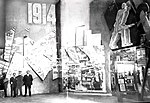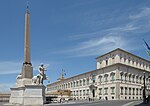Sant'Andrea al Quirinale

The Church of Saint Andrew on the Quirinal (Italian: Sant'Andrea al Quirinale, Latin: S. Andreae in Quirinali) is a Roman Catholic titular church in Rome, Italy, built for the Jesuit seminary on the Quirinal Hill. The church of Sant'Andrea, an important example of Roman Baroque architecture, was designed by Gian Lorenzo Bernini with Giovanni de'Rossi. Bernini received the commission in 1658 and the church was constructed by 1661, although the interior decoration was not finished until 1670. The site previously accommodated a 16th-century church, Sant'Andrea a Montecavallo. Commissioned by former Cardinal Camillo Francesco Maria Pamphili, with the approval of Pope Alexander VII, Sant'Andrea was the third Jesuit church constructed in Rome, after the Church of the Gesù and Sant'Ignazio. It was to serve the Jesuit novitiate, which was founded in 1566. Bernini considered the church one of his most perfect works; his son, Domenico, recalled that in his later years, Bernini spent hours sitting inside it, appreciating what he had achieved.The French dramatist Victorien Sardou set the first act of his play La Tosca in the church. It has served as the titular church of Brazilian Cardinal Odilo Scherer since 2007.
Excerpt from the Wikipedia article Sant'Andrea al Quirinale (License: CC BY-SA 3.0, Authors, Images).Sant'Andrea al Quirinale
Via del Quirinale, Rome Municipio Roma I
Geographical coordinates (GPS) Address Phone number Website External links Nearby Places Show on map
Geographical coordinates (GPS)
| Latitude | Longitude |
|---|---|
| N 41.90068 ° | E 12.48934 ° |
Address
Chiesa di Sant'Andrea al Quirinale
Via del Quirinale 30
00187 Rome, Municipio Roma I
Lazio, Italy
Open on Google Maps










